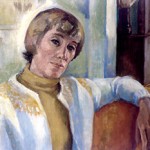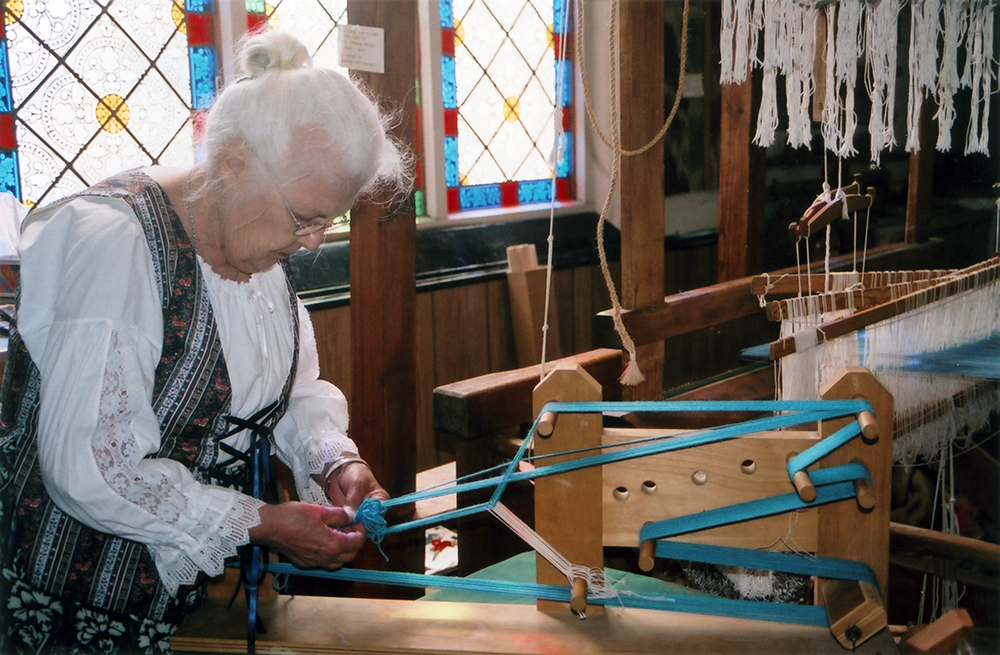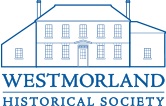The St. James Textile Museum is devoted to the domestic arts of the 19th century. The collection includes various devices used in the production of home-made woolen and linen fabrics, including a loom dating from about 1800. Known as the Beachkirk Collection, most of the items come from southeastern New Brunswick and constitute one of the most important collections of its kind in the Maritimes.

Pamela Black, portait by Faith Wood-Breen
In the 1970s, Pamela Black established a textile studio in the Beachkirk Church, a decommissioned church in Upper Cape. NB. Fueled by a weaver’s passion for traditional handwork and individual craftsmanship, she amassed a textile and fibre collection and set up a workshop and museum.
By 1978 the Beachkirk Fibrecraft Museum housed an extensive and diverse collection of artifacts featuring textiles and fibre, as well as hand-made tools and other objects of craftsmanship reflecting the necessities of everyday life in an agrarian society.
In 1985 Pamela’s collection was relocated to the St. James Textile Museum.

St. James Textile Museum
Weaving and Textiles
200-Year-Old Wooden Loom – The museum is the home of a large loom that was constructed entirely by hand. When Pamela acquired the loom it was disassembled. Fortunately all the components were intact and numbered and with her perseverance it was reassembled and it is still in use today. Also within the museum collection are all the tools required to process raw fibre, such as carders, clock swifts, spinning wheels and other looms. These were generally used by the women of the time to create cloth either from wool, flax, or silk.
The Flax Process – The collection also contains tools for taking raw field flax from its coarse grain, spinning fine threads and weaving white linens.
Accoutrements – The other textiles within the collection reflect not only the necessities of life but an appreciation for beauty through lace making, embroidery or crewelwork, and rug hooking. This collection has a large varied set of embroidery wood stamps used for the patterns in design, as well as patterns from the Ladies Home Journal magazine. The finished products could be decorative, such as our velvet and silk thread runner or necessary everyday items such as gloves, collars and petticoats…or a beautiful child’s christening gown.

Craftsmans’ Tools
Agriculture & Technology
The Harvester – There are a variety of agricultural artifacts such as thrasher and hand made rakes, which were used by men, women and children during the harvest when “all hands” were needed.
The Woodworker – The collection contains a variety of wood working tools including a large functioning lathe used for the construction of furniture and home building.
The Blacksmith – The bellows was used to increase air flow into the forge, to make the fire as hot as possible for working iron. Shoes for horses and cattle as well as the nails for construction were part of the many items forged for the farm and the home.
The Leatherworker – This part of the collection includes a tooling set for leatherwork and foot forms for shoe cobbling. Another highlight is a leather horse collars and a rare horse collar made from bull rushes and used in the summer.
Domestic Life

St. James Textile Museum
The domestic collection is extensive and includes a very unique wooden washing machine and an early floor vacuum. Visit our kitchen hutch where you will find butter processing articles, such as churns and decorative wooden molds from one pound to an individual pat of butter, as well as maple molds for making maple sugar candy.
If you are a history buff, you’ll find more detailed information here:
Domestic Textile Production in Early New Brunswick
by W. Eugene Goodrich
